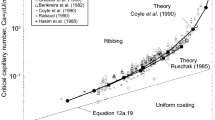Abstract
The computational modelling of reverse roll coating with dynamic wetting line has been analysed for various non-Newtonian viscoelastic materials appealing to the Phan-Thien-Tanner (PTT) network class of models suitable for typical polymer solutions, with properties of shear thinning and strain hardening/softening. The numerical technique utilizes a hybrid finite element-sub-cell finite volume algorithm with a dynamic free-surface location, drawing upon a fractional-staged predictor-corrector semi-implicit time-stepping procedure of an incremental pressure-correction form. The numerical solution is investigated following a systematic study which allows for parametric variation in elasticity (We-variation), extensional hardening-softening (ε), and solvent fraction (β). Under incompressible flow conditions, linear PTT (LPTT) and exponential PTT (EPTT) models were used to solve the paint strip coatings, under reverse roll-coating configuration. This involves two-dimensional planar reverse roll-coating domains, considering a range of Weissenberg numbers (We) up to critical levels, addressing velocity fields and vortex development, pressure and lift profiles, shear rate, and stress fields. Various differences are observed when comparing solutions for these constitutive models. Concerning the effects of elasticity, increase in We stimulates vortex structures, which are visible at both the downstream meniscus and upstream narrowest nip region, whilst decreasing the peak pressure and lift values at the nip constriction. At low values (ε > 0.5, β = 0.1) of extensional viscosity, the LPTT flow fields were much easier to extract, attaining critical We levels up to unity, in contrast to critical We levels of 0.4 for EPTT solutions. This finding is reversed at higher extensional viscosity levels (ε < 0.5). This trend reveals qualitative agreement with theoretical studies. Noting flow behaviour under EPTT solution, increasing the peak level of strain hardening/softening is found to stimulate vortex activity around the nip region, with a corresponding increase in peak pressure and lift values.













Similar content being viewed by others
References
Aboubacar M, Webster MF (2001) A cell-vertex finite volume/element method on triangles for abrupt contraction viscoelastic flows. J Non-Newtonian Fluid Mech 98:83–106
Aboubacar M, Aguayo JP, Phillips PM, Phillips TN, Tamaddon-Jahromi HR, Snigerev BA, Webster MF (2005) Modelling pom-pom type models with high-order finite volume schemes. J Non-Newtonian Fluid Mech 126:207–220
Al-Muslimawi A, Tamaddon-Jahromi HR, Webster MF (2013) Simulation of viscoelastic and viscoelastoplastic die-swell flows. J Non-Newtonian Fluid Mech 191:5–56
Belblidia F, Tamaddon-Jahromi HR, Echendu SOS, Webster MF (2013) Reverse roll-coating flow: a computational investigation towards high-speed defect free coating. Mech Time-Depend Mater. doi:10.1007/s11043-012-9204-y
Carew EO, Townsend P, Webster MF (1993) A Taylor-Petrov-Galerkin algorithm for viscoelastic flow. J Non-Newtonian Fluid Mech 50:253–287
Carew EO, Townsend P, Webster MF (1994) On a discontinuity capturing technique for Oldroyd-B fluids. J Non-Newtonian Fluid Mech 51:231–238
Carvalho MS, Anderson TJ, Scriven LE (1994) Ribbing instability in forward deformable roll coating. In: Proceedings of the 1994 TAPPI coating conference, pp 99–104
Chandio MS, Matallah H, Webster MF (2003) Numerical simulation of viscous filament stretching flows. Int J Num Meth Heat Fluid Flow 13(7):899–930
Donea J (1984) A Taylor–Galerkin method for convective transport problems. Int J Num Meth Eng 20:101–119
Echendu SOS, Tamaddon-Jahromi HR, Webster MF (2013) Modelling reverse roll coating with dynamic wetting lines and inelastic shear thinning fluids. Appl Rheol 23:6. doi:10.3933/ApplRheol-23-62388
Graham MD (2003) Interfacial hoop stress and instability of viscoelastic free surface flows. Phys Fluids 15:1702–1710
Greener J, Middleman S (1975) A theory of roll coating of viscous and viscoelastic fluids. Polym Eng Sci 15(1):1–10
Hawken DM, Townsend P, Webster MF (1991) A comparison of gradient recovery methods in finite-element calculations. Comm Appl Num Meth 7:195–204
Matallah H, Townsend P, Webster MF (1998) Recovery and stress-splitting schemes for viscoelastic flows. J Non-Newtonian Fluid Mech 75:139–166
Phan-Thien N (1977) Influence of wall slip on extrudate swell: a boundary element investigation. J Non-Newtonian Fluid Mech 2:353–365
Ngamaramvaranggul V (2000) Numerical simulation of non-Newtonian free-surface flows. PhD. Thesis, University of Wales Swansea, Swansea
Ngamaramvaranggul V, Webster MF (2002) Simulation of pressure-tooling wire coating flow with Phan-Thien/Tanner models. Int J Num Meth Fluids 38:677–710
Triantafillopoulos NG (1996) Paper coating viscoelasticity and its significance in blade coating. TAPPI Press, Atlanta
Tiu C, Wang L, Liu T-J (1999) Non-Newtonian effects on pre-metered reverse roll coating. J. Non-Newtonian Fluid Mech 87:247–261
Varela López F, Pauchard L, Rosen M, Rabaud M (2002) Non-Newtonian effects on ribbing instability threshold. J Non-Newtonian Fluid Mech 103:123–139
Wapperom P, Webster MF (1998) A second-order hybrid finite-element/volume method for viscoelastic flows. J Non-Newtonian Fluid Mech 79:405–431
Webster MF, Tamaddon-Jahromi HR, Aboubacar M (2005) Time-dependent algorithm for viscoelastic flow-finite element/ volume schemes. Num Meth Partial Differ Equ 21:272– 296
Zevallos GA, Carvalho MS, Pasquali M (2005) Forward roll coating flows of viscoelastic liquids. J Non-Newtonian Fluid Mech 130:96–109
Acknowledgments
This research work was supported by funding from the Engineering and Physical Sciences research council, TATA Steel UK and SPECIFIC-IKC.
Author information
Authors and Affiliations
Corresponding author
Rights and permissions
About this article
Cite this article
Echendu, S.O.S., Tamaddon-Jahromi, H.R. & Webster, M.F. Viscoelastic computations for reverse roll coating with dynamic wetting lines and the Phan-Thien-Tanner models. Rheol Acta 53, 315–331 (2014). https://doi.org/10.1007/s00397-014-0761-7
Received:
Revised:
Accepted:
Published:
Issue Date:
DOI: https://doi.org/10.1007/s00397-014-0761-7




